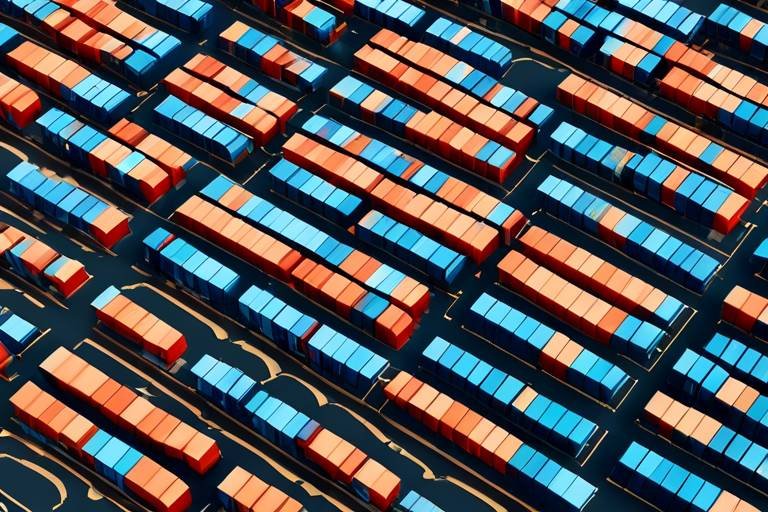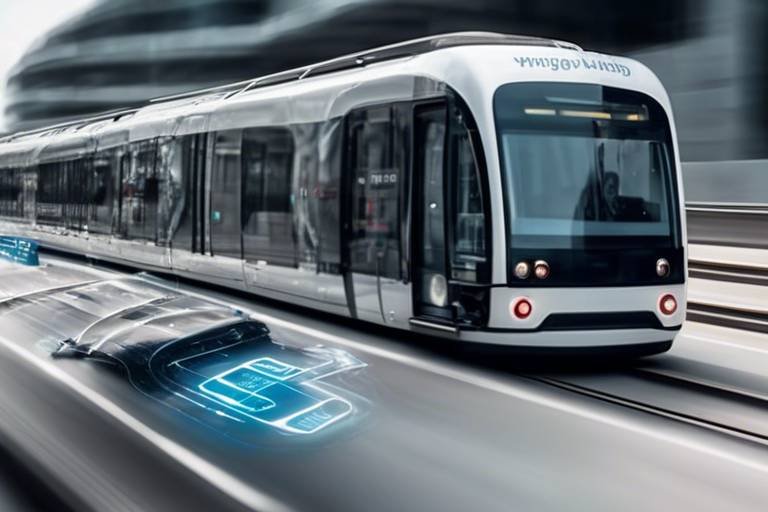Innovations in AI for Climate Change Mitigation
As the world grapples with the escalating impacts of climate change, the **integration of artificial intelligence (AI)** into environmental strategies is proving to be a game-changer. This article explores how AI is not just a buzzword in tech circles, but a powerful ally in the fight against climate change. From advanced climate modeling to smart energy management systems, AI is paving the way for innovative solutions that can significantly reduce greenhouse gas emissions and promote sustainable practices. The potential of AI in this arena is immense, and its applications are as diverse as they are impactful.
Imagine a world where **data-driven insights** empower us to make smarter decisions about our planet. AI algorithms are revolutionizing climate modeling, providing us with more accurate predictions and simulations than ever before. This enables policymakers to craft informed strategies that address climate challenges head-on. It's akin to having a weather forecaster who not only predicts the storm but also helps you prepare for it effectively. The implications of this technology are profound, as they allow for proactive rather than reactive measures in climate action.
Moreover, AI-driven energy management systems are optimizing energy consumption across various sectors. By analyzing usage patterns in buildings and industries, these systems minimize waste and enhance efficiency—two critical components in lowering our carbon footprints. Think of it as having a personal energy assistant that ensures you use only what you need, cutting down on unnecessary waste. This is not just about saving money; it's about contributing to a more sustainable future.
Advanced AI algorithms are transforming climate modeling by providing more accurate predictions and simulations. By leveraging vast amounts of data, these algorithms can identify trends and correlations that were previously undetectable. This allows for a deeper understanding of climate dynamics, enabling policymakers to make informed decisions that can lead to effective climate strategies. For instance, AI can help forecast the impacts of potential policy changes, ensuring that actions taken today will yield positive outcomes in the future.
AI-driven energy management systems are at the forefront of optimizing energy consumption in buildings and industries. These systems analyze real-time data to identify inefficiencies and suggest improvements, ultimately leading to a significant reduction in carbon emissions. The impact is not just limited to energy savings; it also promotes a culture of sustainability within organizations. As businesses adopt these technologies, they not only lower their operational costs but also contribute to a greener planet, showcasing the **synergy between profitability and sustainability**.
Another fascinating application of AI is in the realm of renewable energy. By predicting maintenance needs for solar panels and wind turbines, AI enhances the reliability of these energy sources. This predictive capability minimizes downtime and maximizes energy production, ensuring that we harness the full potential of renewable resources. Imagine a wind farm where each turbine is monitored in real-time, allowing for immediate adjustments to optimize performance—this is the future that AI is helping us build.
Machine learning techniques are particularly effective in analyzing weather patterns and energy consumption to optimize solar panel performance. By understanding how sunlight varies throughout the day and across seasons, AI can adjust the angle and orientation of solar panels, maximizing energy capture. This level of precision not only boosts efficiency but also makes solar energy a more viable option for a wider range of applications.
Similarly, AI algorithms assess wind patterns and turbine performance to facilitate real-time adjustments that improve energy output. By continuously learning from operational data, these systems can adapt to changing conditions, ensuring that wind energy remains a reliable source of power. It's like having a seasoned pilot at the helm, making adjustments on the fly to navigate through changing weather conditions.
AI tools are also instrumental in helping organizations monitor and analyze their carbon footprints. By providing insights into energy usage and emissions, these tools enable businesses to identify opportunities for reduction and implement sustainable practices effectively. It’s akin to having a personal trainer for your environmental impact, guiding you on how to reduce your carbon footprint and live a more sustainable lifestyle.
- What are the main benefits of using AI in climate change mitigation?
AI provides enhanced predictive capabilities, optimizes energy consumption, and helps track carbon footprints, making it an essential tool for effective climate action. - How does AI improve renewable energy efficiency?
AI predicts maintenance needs and optimizes performance based on real-time data, ensuring maximum energy production from renewable sources. - Can AI help in urban planning?
Yes, AI plays a crucial role in developing smart cities, optimizing traffic flow, and improving resource management for sustainable living.

AI-Powered Climate Modeling
In the fight against climate change, is emerging as a game-changer. Traditional climate models, while valuable, often struggle with the vast complexity of Earth's systems. However, advanced AI algorithms are stepping in to revolutionize this field. By harnessing the power of machine learning and big data analytics, researchers can now create models that are not only more accurate but also more adaptable to changing conditions.
Imagine trying to predict the weather a week in advance with only a handful of observations. It’s like trying to find a needle in a haystack! Now, picture AI as a supercharged magnifying glass that can sift through mountains of data to find that needle with ease. This is what AI brings to climate modeling. By analyzing vast datasets from various sources, including satellite imagery, historical climate data, and real-time sensor inputs, AI can uncover patterns and trends that were previously hidden.
One of the most significant advantages of AI in climate modeling is its ability to enhance predictive accuracy. For instance, AI algorithms can simulate numerous scenarios and outcomes based on different variables, such as greenhouse gas emissions and land use changes. This capability allows policymakers to explore various strategies for mitigating climate change and to make informed decisions that can lead to effective action.
Moreover, AI can facilitate collaborative efforts among scientists, governments, and organizations. By creating shared platforms that utilize AI-driven models, stakeholders can work together more efficiently to address climate challenges. This collaboration is crucial, as climate change is a global issue that requires collective action. The ability to visualize potential impacts through AI-enhanced models helps to communicate complex data in a digestible way, fostering greater understanding and engagement.
To illustrate the impact of AI in climate modeling, consider the following table that outlines some of the key advancements:
| Advancement | Description | Impact |
|---|---|---|
| Improved Data Processing | AI algorithms can analyze vast datasets quickly and accurately. | Faster and more reliable predictions. |
| Scenario Simulation | Models can simulate various climate scenarios based on different variables. | Informed decision-making for policymakers. |
| Real-Time Updates | AI models can integrate real-time data for continuous improvement. | More accurate and timely climate responses. |
In conclusion, the integration of AI in climate modeling is not just a technological advancement; it is a necessary evolution in our approach to understanding and combating climate change. As we continue to develop these innovative tools, the potential for creating a more sustainable future becomes increasingly tangible. The collaboration between AI and climate science is paving the way for a more informed and proactive response to one of the most pressing challenges of our time.

Smart Energy Management Systems
In today's fast-paced world, the need for efficient energy consumption has never been more critical. Enter Smart Energy Management Systems (SEMS), a groundbreaking approach that leverages artificial intelligence to optimize energy use in both residential and commercial settings. Imagine a system that not only tracks energy consumption in real-time but also learns from patterns and predicts future needs. That's the magic of AI at work!
Smart Energy Management Systems analyze data from various sources, including weather forecasts, energy usage patterns, and even occupancy levels, to make informed decisions about energy distribution. This means that instead of relying on outdated methods, buildings can dynamically adjust their energy consumption based on actual needs. For instance, during peak hours, the system can reduce energy use in less critical areas, ensuring that essential functions remain uninterrupted while minimizing waste.
One of the most exciting aspects of SEMS is their ability to integrate with renewable energy sources. By using predictive analytics, these systems can determine the optimal times to draw energy from solar panels or wind turbines, maximizing the use of clean energy and reducing reliance on fossil fuels. This not only lowers operational costs but also significantly reduces greenhouse gas emissions. The synergy between AI and renewable energy is a game-changer in the fight against climate change.
Moreover, the implementation of Smart Energy Management Systems can lead to substantial financial savings. Businesses that adopt these technologies often see a reduction in energy costs by as much as 30% to 50%. This is achieved through:
- Real-time monitoring and reporting of energy usage
- Automated control of heating, ventilation, and air conditioning (HVAC) systems
- Integration with smart appliances and devices
- Data analytics to identify inefficiencies and areas for improvement
To illustrate the impact of SEMS, consider the following table that showcases energy savings across different sectors:
| Sector | Energy Cost Reduction (%) | CO2 Emissions Reduction (%) |
|---|---|---|
| Commercial Buildings | 30% | 25% |
| Manufacturing | 40% | 35% |
| Residential | 20% | 15% |
As we move towards a more sustainable future, the role of Smart Energy Management Systems becomes increasingly vital. By utilizing AI and machine learning, these systems not only enhance energy efficiency but also contribute to a greener planet. So, why not embrace this technological revolution? With SEMS, we can all play our part in combating climate change while enjoying the benefits of reduced energy costs and improved operational efficiency.
Q: What is a Smart Energy Management System?
A: A Smart Energy Management System is a technology that uses artificial intelligence to optimize energy consumption in buildings by analyzing data and making real-time adjustments.
Q: How much can businesses save by implementing SEMS?
A: Businesses can save between 30% to 50% on energy costs by using Smart Energy Management Systems.
Q: Can SEMS integrate with renewable energy sources?
A: Yes, SEMS can integrate with renewable energy sources, optimizing their use and reducing reliance on fossil fuels.
Q: What are the environmental benefits of using SEMS?
A: The environmental benefits include significant reductions in greenhouse gas emissions and improved energy efficiency.

Predictive Maintenance in Renewable Energy
When it comes to renewable energy, reliability is key. Imagine a world where solar panels and wind turbines operate at peak efficiency without unexpected breakdowns. That's where predictive maintenance comes into play. By leveraging advanced AI technologies, energy producers can anticipate equipment failures before they occur, ensuring a steady flow of clean energy. This not only maximizes energy production but also significantly reduces operational costs.
At its core, predictive maintenance utilizes data analytics and machine learning algorithms to monitor the health of renewable energy systems. Sensors collect real-time data on various parameters, such as temperature, vibration, and performance metrics. AI then analyzes this data to identify patterns and predict when a component is likely to fail. This proactive approach allows for maintenance to be scheduled during non-peak times, minimizing downtime and maximizing output.
For instance, consider a wind farm with multiple turbines. Each turbine is equipped with sensors that monitor its performance. When AI detects anomalies—like a drop in efficiency or unusual vibrations—it can alert maintenance teams. This early warning system enables technicians to address potential issues before they escalate, preventing costly repairs and loss of energy production.
Furthermore, predictive maintenance can lead to a more sustainable approach to energy production. By reducing the need for emergency repairs and unscheduled maintenance, companies can decrease their carbon footprint. This is particularly important in the renewable sector, where the goal is to minimize environmental impact while maximizing output.
To illustrate the benefits, let's look at some key advantages of predictive maintenance in renewable energy:
| Advantage | Description |
|---|---|
| Cost Savings | Reduces unplanned downtime and emergency repairs, leading to lower operational costs. |
| Increased Efficiency | Ensures equipment operates at optimal performance, maximizing energy production. |
| Sustainability | Minimizes the environmental impact by reducing waste and improving resource management. |
In conclusion, predictive maintenance is not just a trend; it’s a transformative approach that enhances the reliability of renewable energy systems. By utilizing AI to predict and prevent failures, companies can ensure a steady supply of clean energy while also promoting sustainable practices. As we continue to embrace renewable energy sources, the importance of predictive maintenance will only grow, paving the way for a greener future.
- What is predictive maintenance? Predictive maintenance is a proactive maintenance strategy that uses data analytics and machine learning to predict when equipment might fail, allowing for timely interventions.
- How does AI contribute to predictive maintenance? AI analyzes real-time data from sensors to identify patterns and anomalies, enabling early detection of potential issues in renewable energy systems.
- What are the benefits of predictive maintenance in renewable energy? Key benefits include cost savings, increased efficiency, and reduced environmental impact.

Machine Learning for Solar Energy Optimization
When it comes to harnessing the power of the sun, machine learning is like having a super-smart assistant that can analyze vast amounts of data in the blink of an eye. Imagine trying to predict the weather for the entire year based on just a few days of sunshine—daunting, right? But with machine learning, we can process historical weather data, solar panel performance metrics, and even geographic information to make precise predictions about how much energy a solar panel will generate on any given day.
One of the most exciting aspects of machine learning in solar energy optimization is its ability to adapt and learn over time. For instance, by continuously analyzing data from solar panels, machine learning algorithms can identify patterns and anomalies that humans might miss. This means that if a solar panel isn’t performing as expected, the system can automatically adjust its settings or alert maintenance teams to take action. It’s like having a personal trainer for your solar panels, ensuring they’re always operating at peak performance.
Moreover, machine learning can optimize the placement of solar panels. By analyzing factors such as sunlight exposure, shading from nearby structures, and even seasonal changes, machine learning algorithms can recommend the best locations for solar installations. This not only maximizes energy capture but also improves the overall efficiency of solar farms, making them more profitable and sustainable.
To put this into perspective, consider a solar farm that utilizes machine learning to analyze weather forecasts and adjust its energy output accordingly. If a storm is predicted, the system can preemptively shift energy storage strategies, ensuring that excess energy is stored for later use. This proactive approach can lead to significant savings and a more reliable energy supply.
Here’s a quick overview of how machine learning enhances solar energy optimization:
| Machine Learning Application | Benefit |
|---|---|
| Performance Monitoring | Identifies underperforming panels for maintenance |
| Predictive Analytics | Forecasts energy production based on weather data |
| Site Optimization | Determines optimal panel placement for maximum efficiency |
| Energy Storage Management | Adjusts storage strategies based on predicted output |
In summary, the integration of machine learning into solar energy systems not only enhances efficiency but also contributes to a more sustainable future. With its ability to learn and adapt, machine learning is paving the way for smarter solar energy solutions that can meet our growing energy demands while minimizing environmental impact. So, the next time you see a solar panel, remember that behind its operation lies a complex web of data and algorithms working tirelessly to optimize its performance!
- How does machine learning improve solar energy efficiency? Machine learning analyzes data from solar panels to identify performance issues, optimize energy output, and enhance maintenance schedules.
- Can machine learning predict solar energy production? Yes, by utilizing historical weather data and solar panel performance metrics, machine learning algorithms can forecast energy production with remarkable accuracy.
- What are the benefits of using machine learning in solar farms? Benefits include improved energy capture, reduced downtime, optimized panel placement, and enhanced maintenance strategies.

AI in Wind Turbine Efficiency
As the world pivots towards renewable energy sources, wind energy stands out as a powerful contender in the fight against climate change. However, maximizing the efficiency of wind turbines is crucial to harnessing their full potential. This is where artificial intelligence (AI) steps in, revolutionizing the way we monitor and manage wind turbine operations. With the help of advanced algorithms, AI can analyze vast amounts of data in real-time, enabling operators to make informed decisions that enhance turbine performance.
One of the primary ways AI boosts wind turbine efficiency is through the assessment of wind patterns. By utilizing machine learning techniques, AI systems can predict changes in wind speed and direction, allowing for real-time adjustments to turbine blades. Imagine a conductor leading an orchestra; just as the conductor ensures each musician plays in harmony, AI ensures that each turbine operates at its peak performance, adjusting to the ever-changing conditions of the wind.
Furthermore, AI can facilitate predictive maintenance, which is essential for minimizing downtime and maximizing energy production. By analyzing historical data and operational metrics, AI can identify patterns that indicate when a turbine is likely to need maintenance. This proactive approach not only reduces the risk of unexpected failures but also extends the lifespan of the equipment. For instance, if a turbine has been underperforming due to a mechanical issue, AI can alert technicians before it becomes a significant problem, much like a doctor diagnosing a condition before it escalates.
To illustrate the impact of AI on wind turbine efficiency, consider the following table that highlights the benefits of AI integration:
| Benefit | Description |
|---|---|
| Real-Time Data Analysis | AI analyzes wind data instantaneously, allowing for immediate adjustments to turbine operations. |
| Predictive Maintenance | Identifies potential mechanical issues before they lead to turbine failure. |
| Increased Energy Output | Optimizes turbine performance, leading to higher energy production from available wind resources. |
| Cost Efficiency | Reduces maintenance costs and downtime, ultimately saving money for operators. |
In conclusion, the integration of AI in wind turbine operations is not just a trend; it’s a necessity for achieving sustainable energy goals. As we continue to innovate and harness the power of AI, we can look forward to a future where wind energy plays a pivotal role in our energy landscape, driving us closer to a greener planet.
- How does AI improve wind turbine efficiency? AI analyzes real-time data to optimize turbine operations and predict maintenance needs, resulting in increased energy output.
- What are the benefits of predictive maintenance in wind turbines? Predictive maintenance helps prevent unexpected failures, reduces downtime, and extends the lifespan of the turbines.
- Can AI help reduce the costs associated with wind energy? Yes, by minimizing maintenance costs and optimizing energy production, AI can lead to significant savings for operators.

Carbon Footprint Tracking and Reduction
In today's world, where climate change looms large, understanding and mitigating our carbon footprint is more crucial than ever. Thanks to the advancements in artificial intelligence, organizations are now equipped with powerful tools that enable them to monitor, analyze, and ultimately reduce their carbon emissions effectively. Imagine being able to track your carbon output in real-time, just like checking your bank balance. This is the reality that AI is helping to create.
AI-driven tools allow businesses and individuals to gather data from various sources, such as energy consumption, transportation habits, and even waste production. By utilizing sophisticated algorithms, these tools can analyze vast amounts of data to identify patterns and pinpoint areas where emissions can be reduced. For instance, a company might discover that a specific department is using significantly more energy than others, prompting them to investigate and implement energy-saving measures. This proactive approach not only helps in cutting costs but also contributes to a more sustainable future.
Moreover, AI can facilitate the creation of comprehensive carbon footprint reports that provide insights into how different activities contribute to overall emissions. These reports can be tailored to meet the needs of various stakeholders, from corporate executives to environmental analysts. By presenting data in a visually appealing format, such as graphs and charts, organizations can better understand their environmental impact and make informed decisions.
| Carbon Emission Sources | Reduction Strategies |
|---|---|
| Transportation | Implementing carpooling and using electric vehicles |
| Energy Consumption | Adopting energy-efficient appliances and renewable energy sources |
| Waste Production | Enhancing recycling programs and reducing single-use plastics |
In addition to tracking carbon footprints, AI also plays a significant role in recommending reduction strategies. For example, machine learning algorithms can analyze historical data to suggest the most effective measures based on a company’s specific emissions profile. This tailored approach ensures that organizations can focus their efforts where they will have the most substantial impact.
Furthermore, the integration of AI with IoT (Internet of Things) devices allows for real-time monitoring of emissions. Imagine a smart building equipped with sensors that detect energy usage and automatically adjust systems to optimize performance. This not only leads to immediate reductions in carbon emissions but also fosters a culture of sustainability within the organization.
Ultimately, the journey towards reducing our carbon footprints is a collaborative effort. By harnessing the power of AI, individuals and organizations can work together to create a more sustainable future. The insights gained from AI-driven tools empower us to make better choices, paving the way for a healthier planet. So, are you ready to take that first step towards reducing your carbon footprint?
- What is a carbon footprint?
A carbon footprint is the total amount of greenhouse gases, primarily carbon dioxide, that are emitted directly or indirectly by an individual, organization, event, or product.
- How can AI help in tracking carbon footprints?
AI can analyze large datasets from various sources to provide insights into emissions, identify patterns, and suggest effective reduction strategies.
- What are some practical steps to reduce my carbon footprint?
Consider using energy-efficient appliances, reducing car travel, recycling, and supporting renewable energy initiatives.
- Can small businesses benefit from AI in carbon footprint tracking?
Absolutely! AI tools can help small businesses identify inefficiencies and implement sustainable practices, often leading to cost savings.

AI-Enhanced Agricultural Practices
Artificial intelligence is revolutionizing the agricultural landscape, making it possible for farmers to optimize their resource use, improve crop yields, and significantly reduce emissions. Picture a farmer standing in a vast field, equipped not just with traditional tools, but with advanced technology that allows them to make data-driven decisions. This transformation is not just a dream; it's happening right now, thanks to AI.
One of the most exciting aspects of AI in agriculture is the implementation of precision farming techniques. These techniques leverage AI to analyze vast amounts of data—everything from soil quality to weather patterns. By utilizing sensors and satellite imagery, farmers can gain insights into the best times to plant, water, and fertilize their crops. For instance, AI can identify specific areas in a field that require more nutrients or water, ensuring that resources are used efficiently. This not only conserves water and fertilizers but also results in healthier crops and higher yields.
Moreover, AI systems are becoming increasingly adept at automated pest and disease management. Imagine a scenario where a farmer can detect early signs of a pest infestation or a plant disease before it spreads. AI algorithms can analyze images taken by drones or smartphones to identify these threats in real-time. This proactive approach allows farmers to implement targeted interventions, reducing the need for harmful pesticides and chemicals. In turn, this leads to healthier crops and a more sustainable farming practice.
To illustrate the impact of AI on agricultural efficiency, consider the following table that outlines key benefits:
| Benefit | Description |
|---|---|
| Resource Optimization | AI enables precise application of water, fertilizers, and pesticides, minimizing waste. |
| Increased Yields | Data-driven insights lead to better crop management and higher productivity. |
| Reduced Emissions | Efficient practices lower the carbon footprint associated with farming. |
| Enhanced Decision-Making | Real-time data helps farmers make informed decisions quickly. |
As we embrace these innovative practices, it's essential to recognize that AI is not a replacement for traditional farming methods; rather, it serves as a powerful ally. Farmers can harness the capabilities of AI to enhance their existing knowledge and experience. This combination of human intuition and machine intelligence creates a robust framework for tackling the challenges posed by climate change and food security.
In conclusion, AI-enhanced agricultural practices are not just a trend; they represent a fundamental shift in how we approach farming. With technology evolving at an unprecedented pace, the future of agriculture looks promising. Farmers who adopt these practices will not only benefit from increased efficiency and productivity but also contribute to a more sustainable world. Are you ready to embrace the future of farming?
- How does AI improve crop yields? AI analyzes data from various sources to optimize planting schedules and resource allocation, leading to healthier crops and higher yields.
- Can AI help reduce pesticide use? Yes, AI can detect pests and diseases early, allowing for targeted interventions that minimize the need for chemicals.
- Is AI technology expensive for farmers? While there may be initial costs, the long-term savings and increased productivity often outweigh these expenses.
- How can small farmers benefit from AI? Many AI solutions are scalable and can be tailored to the needs of small farmers, providing them with tools to optimize their operations.

Precision Agriculture Techniques
In the ever-evolving world of agriculture, are at the forefront of innovation, transforming how farmers approach crop management. This modern farming method leverages cutting-edge technologies like AI, GPS, and IoT devices to optimize the use of resources, enhance crop yields, and minimize environmental impact. Imagine a farmer equipped with a digital toolkit that provides real-time data about soil conditions, moisture levels, and even pest threats. This is not just a dream—it's the reality that precision agriculture brings to the table.
One of the key components of precision agriculture is the use of data analytics. By collecting data from various sources, farmers can make informed decisions that lead to more sustainable practices. For instance, sensors placed throughout the fields can monitor soil health and moisture content, allowing farmers to apply water and fertilizers only where and when they are needed. This targeted approach not only saves resources but also reduces runoff, which can harm local ecosystems.
Moreover, drone technology has revolutionized how farmers survey their land. Drones equipped with high-resolution cameras can capture images that reveal crop health and growth patterns. This aerial perspective enables farmers to identify problem areas quickly, allowing them to act before minor issues escalate into major losses. The efficiency gained through these technologies can be likened to having a personal assistant who knows exactly what needs to be done and when.
Another fascinating aspect of precision agriculture is the use of machine learning algorithms. These algorithms analyze vast amounts of data to identify trends and patterns that human eyes might miss. For example, they can predict the optimal time for planting or harvesting based on historical weather data and current conditions. This predictive capability empowers farmers to maximize their yields while minimizing waste, ensuring that every seed planted has the best chance of thriving.
To give you a clearer picture of how these techniques work together, consider the following table that summarizes the main technologies used in precision agriculture:
| Technology | Function | Benefits |
|---|---|---|
| GPS | Field mapping and tracking | Improved accuracy in planting and resource allocation |
| Sensors | Soil and crop monitoring | Real-time data for precise interventions |
| Drones | Aerial surveying | Quick identification of crop health issues |
| Machine Learning | Data analysis and predictions | Enhanced decision-making capabilities |
In conclusion, precision agriculture techniques are not just about technology; they represent a paradigm shift in how we think about food production. By harnessing the power of AI and data analytics, farmers can achieve a level of efficiency and sustainability that was previously unimaginable. This is the future of farming—where every decision is backed by data, and every action contributes to a healthier planet.
- What is precision agriculture? Precision agriculture is a farming management concept that uses technology to monitor and manage field variability in crops to improve yield and sustainability.
- How does AI contribute to precision agriculture? AI analyzes data collected from various sources to optimize farming practices, predict crop yields, and enhance decision-making processes.
- What technologies are commonly used in precision agriculture? Technologies include GPS, drones, sensors, and machine learning algorithms.
- Can precision agriculture reduce environmental impact? Yes, by optimizing resource use, precision agriculture minimizes waste and reduces harmful runoff, promoting sustainability.

Automated Pest and Disease Management
In the ever-evolving landscape of agriculture, has emerged as a game-changer. Imagine a world where farmers can predict pest invasions or crop diseases before they even occur. Sounds like something out of a sci-fi movie, right? But thanks to advancements in artificial intelligence, this is becoming a reality. By leveraging data and machine learning algorithms, farmers can monitor their crops in real-time, identifying potential threats and addressing them proactively.
One of the most fascinating aspects of this technology is its ability to analyze vast amounts of data from various sources. For instance, AI systems can process information from satellite images, weather patterns, and even soil health metrics. This data is then used to create predictive models that can forecast pest outbreaks and disease spread. The result? Farmers can implement targeted interventions, which not only saves time but also reduces the need for chemical treatments, promoting a healthier ecosystem.
But how does this work in practice? Let’s take a closer look at some of the techniques involved:
- Image Recognition: AI-powered cameras and drones can capture images of crops, allowing algorithms to detect early signs of pest infestations or diseases. This real-time monitoring means that farmers can act swiftly, often before the issue escalates.
- Data Integration: By combining data from various sources, such as soil sensors and weather forecasts, AI systems can provide a comprehensive overview of crop health. This holistic approach helps in making informed decisions regarding pest management.
- Targeted Treatments: Instead of blanket spraying pesticides, AI can recommend specific treatments for affected areas, significantly reducing chemical use and minimizing environmental impact.
Furthermore, the impact of automated pest and disease management extends beyond just crop yield. It contributes to sustainable farming practices by promoting biodiversity and reducing chemical runoff into nearby waterways. Farmers who adopt these technologies not only enhance their productivity but also play a vital role in preserving the environment for future generations.
In conclusion, automated pest and disease management powered by AI is not just a trend; it’s a revolutionary approach that is reshaping the agricultural landscape. As these technologies continue to evolve, we can expect even more innovative solutions to emerge, making farming more efficient, sustainable, and resilient against the challenges posed by pests and diseases.
Q1: How does automated pest management reduce chemical use?
A1: Automated pest management systems utilize AI to identify pests and diseases early, allowing for targeted interventions instead of widespread pesticide application. This leads to a significant reduction in chemical use.
Q2: Can automated systems work in different types of crops?
A2: Yes! AI systems are adaptable and can be trained to monitor various crops, making them versatile tools for farmers across different agricultural sectors.
Q3: What are the cost implications of implementing AI in agriculture?
A3: While the initial investment in AI technology may be significant, the long-term benefits, including increased yields and reduced chemical costs, often outweigh the costs, making it a worthwhile investment for many farmers.

Urban Planning and Smart Cities
In today's rapidly evolving world, the concept of smart cities is gaining significant traction, driven largely by the integration of artificial intelligence (AI) into urban planning. Imagine a city where traffic flows seamlessly, energy consumption is optimized, and public services are delivered efficiently. This vision is becoming a reality as cities leverage AI to create more sustainable and livable environments.
One of the most pressing challenges urban planners face is managing the ever-increasing population density. With more people comes more vehicles, more waste, and a greater demand for resources. Here, AI steps in as a powerful ally. By analyzing vast amounts of data from various sources—such as traffic sensors, weather forecasts, and social media—AI can help city officials make informed decisions that enhance urban life.
For instance, AI algorithms can optimize traffic management systems in real-time. They can analyze traffic patterns and predict congestion before it happens, providing alternative routes to drivers and reducing overall emissions. This not only improves air quality but also enhances the quality of life for residents. Imagine a morning commute where you spend less time stuck in traffic, allowing you to enjoy a leisurely breakfast instead!
Moreover, AI is instrumental in developing smart public transportation systems. By using predictive analytics, cities can adjust bus and train schedules based on real-time demand, ensuring that public transport is both efficient and convenient. This encourages more people to leave their cars at home, further decreasing carbon emissions and traffic congestion.
Another significant aspect of urban planning is energy efficiency in buildings. AI technologies are being integrated into the design and operation of new constructions. For example, smart buildings equipped with AI can monitor energy usage and adjust heating, cooling, and lighting systems automatically. This not only reduces energy consumption but also lowers utility costs for residents and businesses alike.
To illustrate the impact of AI in urban planning, consider the following table that summarizes key benefits:
| AI Application | Benefits |
|---|---|
| Traffic Management | Reduced congestion, lower emissions, improved air quality |
| Public Transport Optimization | Increased efficiency, better service, reduced reliance on cars |
| Energy Management | Lower energy consumption, reduced costs, enhanced sustainability |
As we look to the future, the integration of AI into urban planning is not just a trend; it is a necessity. Cities worldwide are already beginning to adopt smart technologies, paving the way for a more sustainable future. The potential for AI to transform urban living is immense, making our cities not only smarter but also more resilient to the challenges posed by climate change.
- What are smart cities? Smart cities utilize technology and data to improve the quality of life for residents through efficient urban planning and resource management.
- How does AI help in traffic management? AI analyzes real-time data to optimize traffic flow, reduce congestion, and improve air quality.
- What role does AI play in energy efficiency? AI technologies monitor and manage energy consumption in buildings, leading to reduced waste and lower costs.

Traffic Management Solutions
In our fast-paced world, traffic congestion is a common headache that affects millions of commuters daily. But what if I told you that artificial intelligence is stepping in to transform this urban nightmare into a smoother, more efficient experience? AI-driven traffic management solutions are not just a futuristic dream; they are actively reshaping how we navigate our cities today. By leveraging vast amounts of data from various sources, these systems can optimize traffic flow, reduce wait times, and ultimately lower vehicle emissions.
Imagine a city where traffic lights adapt in real-time to the number of vehicles on the road. AI algorithms analyze live traffic data, adjusting signal timings to ensure that vehicles move seamlessly through intersections. This dynamic approach minimizes congestion and enhances the overall driving experience. But how does it work? Let’s break it down:
- Data Collection: Sensors, cameras, and GPS data from vehicles collect information on traffic patterns, speeds, and volumes.
- Analysis: AI algorithms process this data to identify trends and predict traffic conditions.
- Real-Time Adjustments: Based on the analysis, traffic signals and signs are adjusted instantly to optimize flow.
Moreover, AI can also facilitate better public transportation systems. By predicting peak travel times and adjusting bus and train schedules accordingly, cities can encourage more residents to opt for public transport over personal vehicles. This shift not only helps reduce emissions but also alleviates the burden on road infrastructures.
Another fascinating application of AI in traffic management is the use of smart parking solutions. Imagine driving through a bustling city, and instead of endlessly circling blocks searching for a parking spot, your car is guided directly to the nearest available space. AI systems can analyze parking availability in real-time, guiding drivers to open spots and reducing the time spent searching for parking. This not only saves time but also cuts down on the emissions produced by idling vehicles.
As cities continue to grow, the integration of AI in traffic management is becoming increasingly essential. The benefits extend beyond just improved traffic flow; they also lead to enhanced safety. AI systems can detect unusual patterns that may indicate accidents or hazards, alerting emergency services faster than traditional methods. This proactive approach to traffic management could save lives and reduce the severity of accidents.
In summary, AI is revolutionizing traffic management solutions by providing smarter, more efficient ways to navigate urban environments. With real-time data analysis, adaptive traffic signals, and innovative parking solutions, cities can become more sustainable and livable. The future of urban mobility is bright, and AI is lighting the way.
Q1: How does AI help in reducing traffic congestion?
A1: AI analyzes real-time traffic data to optimize signal timings, manage traffic flow, and predict peak travel times, which helps in reducing congestion.
Q2: What role does AI play in public transportation?
A2: AI can optimize public transport schedules based on predicted demand, encouraging more people to use public transit and reducing reliance on personal vehicles.
Q3: Are smart parking solutions effective?
A3: Yes, smart parking solutions use AI to provide real-time information on available parking spaces, significantly reducing the time drivers spend searching for parking.
Q4: How can AI improve road safety?
A4: AI can detect unusual traffic patterns or hazards and alert emergency services quickly, leading to faster responses to accidents and potentially saving lives.

Building Energy Efficiency Innovations
As we march towards a more sustainable future, the integration of artificial intelligence in building energy efficiency is nothing short of revolutionary. Imagine a world where buildings not only serve as shelters but also actively contribute to reducing our carbon footprint. This is becoming a reality thanks to innovative technologies that harness AI to optimize energy use. By implementing smart systems, we can dramatically improve energy efficiency in both new constructions and renovated spaces.
One of the most exciting aspects of these innovations is the use of intelligent building management systems. These systems leverage AI to monitor and control energy consumption in real-time. For instance, they can adjust heating, ventilation, and air conditioning (HVAC) systems based on occupancy levels and weather conditions, ensuring that energy is used only when necessary. This not only saves money but also significantly reduces greenhouse gas emissions.
Another key innovation is the incorporation of smart sensors throughout buildings. These sensors can detect a variety of factors, such as temperature, humidity, and even the number of people in a room. By analyzing this data, AI can optimize energy usage in ways that were previously unimaginable. For example, if a conference room is empty, the system can automatically lower the temperature or turn off lights, leading to substantial energy savings.
Moreover, the integration of renewable energy sources into building designs is becoming increasingly common. AI can manage the energy generated from solar panels or wind turbines, ensuring that it is used efficiently. With predictive analytics, buildings can forecast energy production and consumption, allowing for smarter energy distribution. This synergy between AI and renewable energy is a game-changer, making buildings not just consumers of energy, but also producers.
To give you a clearer picture, here’s a
| Innovation | Description | Benefits |
|---|---|---|
| Intelligent Building Management Systems | Real-time monitoring and control of energy systems | Reduces energy waste and lowers operational costs |
| Smart Sensors | Detects occupancy and environmental conditions | Optimizes energy use based on real-time data |
| Integration of Renewable Energy | Utilizes solar and wind energy within building systems | Reduces reliance on fossil fuels and lowers emissions |
In addition to these technologies, the concept of green building certifications is gaining traction. Certifications such as LEED (Leadership in Energy and Environmental Design) encourage the adoption of energy-efficient practices in construction. Buildings that achieve these certifications often see an increase in property value and attractiveness to tenants, making it a win-win situation for developers and the environment alike.
As we look to the future, the potential for AI in enhancing building energy efficiency is limitless. With continuous advancements in technology, we can expect to see even more sophisticated solutions that not only improve energy efficiency but also contribute to a more sustainable urban environment. The question is, are we ready to embrace these innovations and make a significant impact on climate change?
- What is building energy efficiency? Building energy efficiency refers to the use of technology and practices to reduce energy consumption in buildings while maintaining comfort and functionality.
- How does AI improve energy efficiency in buildings? AI improves energy efficiency by analyzing data from smart sensors and making real-time adjustments to systems like HVAC and lighting, optimizing energy use based on actual demand.
- What are some benefits of energy-efficient buildings? Benefits include lower energy costs, reduced carbon emissions, improved indoor air quality, and increased property value.
- Are there financial incentives for building energy efficiency? Yes, many governments and organizations offer financial incentives, such as tax credits and grants, to encourage energy-efficient construction and renovations.
Frequently Asked Questions
- What is the role of AI in climate change mitigation?
AI plays a transformative role in climate change mitigation by providing advanced tools for climate modeling, optimizing energy management, and enhancing agricultural practices. It helps in predicting environmental changes and implementing effective strategies to reduce greenhouse gas emissions.
- How does AI improve climate modeling?
Advanced AI algorithms analyze vast amounts of climate data to create more accurate predictions and simulations. This allows policymakers to make informed decisions based on reliable forecasts, ultimately leading to better climate strategies and interventions.
- What are smart energy management systems?
Smart energy management systems utilize AI to optimize energy consumption in buildings and industries. By analyzing usage patterns, these systems reduce waste and promote efficiency, which is essential for lowering carbon footprints and achieving sustainability goals.
- How does AI enhance renewable energy reliability?
AI improves the reliability of renewable energy sources like solar and wind by predicting maintenance needs. This proactive approach minimizes downtime and maximizes energy production, ensuring that these systems operate at peak efficiency.
- What is precision agriculture?
Precision agriculture refers to the use of AI technologies to optimize farming practices. By leveraging data-driven insights, farmers can make informed decisions about planting, watering, and fertilizing, which leads to reduced waste and increased crop yields.
- Can AI help in pest and disease management?
Yes! AI systems can detect early signs of pests and diseases in crops, enabling farmers to implement targeted interventions. This minimizes the need for chemical treatments, enhancing crop health while promoting sustainable practices.
- How does AI contribute to smart city development?
AI contributes to smart city development by enabling data-driven urban planning. This includes optimizing traffic flow, improving public transport, and enhancing resource management, all of which lead to reduced emissions and improved quality of life for residents.
- What are some AI applications in traffic management?
AI applications in traffic management include algorithms that optimize traffic flow and reduce congestion. By analyzing real-time data, these systems help to lower vehicle emissions and improve air quality in urban areas, creating a more sustainable environment.
- How can AI improve building energy efficiency?
AI technologies can be integrated into building designs to enhance energy efficiency. They help ensure that new constructions meet sustainability standards, ultimately minimizing environmental impact while reducing energy costs for occupants.



















